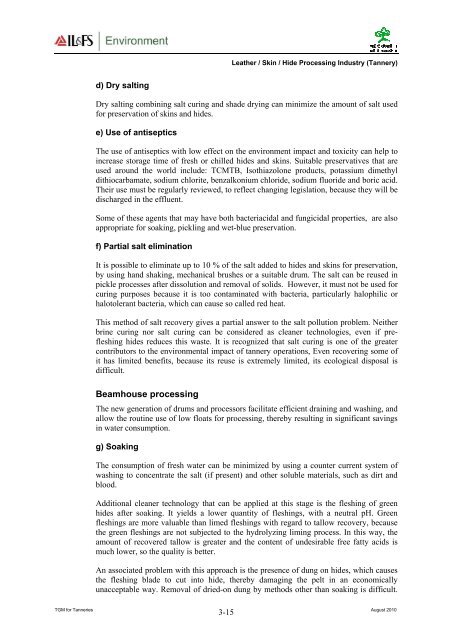Leather/Skin/Hide Processing Industry - Environmental Clearance
Leather/Skin/Hide Processing Industry - Environmental Clearance
Leather/Skin/Hide Processing Industry - Environmental Clearance
You also want an ePaper? Increase the reach of your titles
YUMPU automatically turns print PDFs into web optimized ePapers that Google loves.
<strong>Leather</strong> / <strong>Skin</strong> / <strong>Hide</strong> <strong>Processing</strong> <strong>Industry</strong> (Tannery)d) Dry saltingDry salting combining salt curing and shade drying can minimize the amount of salt usedfor preservation of skins and hides.e) Use of antisepticsThe use of antiseptics with low effect on the environment impact and toxicity can help toincrease storage time of fresh or chilled hides and skins. Suitable preservatives that areused around the world include: TCMTB, Isothiazolone products, potassium dimethyldithiocarbamate, sodium chlorite, benzalkonium chloride, sodium fluoride and boric acid.Their use must be regularly reviewed, to reflect changing legislation, because they will bedischarged in the effluent.Some of these agents that may have both bacteriacidal and fungicidal properties, are alsoappropriate for soaking, pickling and wet-blue preservation.f) Partial salt eliminationIt is possible to eliminate up to 10 % of the salt added to hides and skins for preservation,by using hand shaking, mechanical brushes or a suitable drum. The salt can be reused inpickle processes after dissolution and removal of solids. However, it must not be used forcuring purposes because it is too contaminated with bacteria, particularly halophilic orhalotolerant bacteria, which can cause so called red heat.This method of salt recovery gives a partial answer to the salt pollution problem. Neitherbrine curing nor salt curing can be considered as cleaner technologies, even if prefleshinghides reduces this waste. It is recognized that salt curing is one of the greatercontributors to the environmental impact of tannery operations, Even recovering some ofit has limited benefits, because its reuse is extremely limited, its ecological disposal isdifficult.Beamhouse processingThe new generation of drums and processors facilitate efficient draining and washing, andallow the routine use of low floats for processing, thereby resulting in significant savingsin water consumption.g) SoakingThe consumption of fresh water can be minimized by using a counter current system ofwashing to concentrate the salt (if present) and other soluble materials, such as dirt andblood.Additional cleaner technology that can be applied at this stage is the fleshing of greenhides after soaking. It yields a lower quantity of fleshings, with a neutral pH. Greenfleshings are more valuable than limed fleshings with regard to tallow recovery, becausethe green fleshings are not subjected to the hydrolyzing liming process. In this way, theamount of recovered tallow is greater and the content of undesirable free fatty acids ismuch lower, so the quality is better.An associated problem with this approach is the presence of dung on hides, which causesthe fleshing blade to cut into hide, thereby damaging the pelt in an economicallyunacceptable way. Removal of dried-on dung by methods other than soaking is difficult.TGM for Tanneries August 20103-15
















